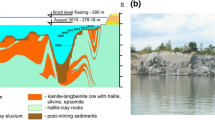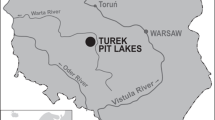Abstract
Lake Plessa 107 is an example of the older, relatively small and often shallow mining lakes of Lusatia which only have groundwater inflow. From a morphological point of view, the lake should be polymictic with short stratified periods. But besides temperature, mixing is also determined by chemical gradients in the water column that can lead up to monomixis. The lake water shows an extreme acidification with high concentrations of calcium, iron, aluminium, manganese and sulphate. Despite low TIC and TP concentrations allowing only a low primary production in the pelagial within the oligotrophic range, anoxic conditions can occur during stratification because of Fe(II) oxidation and anoxic groundwater inflow. The phytoplankton is dominated by phytoflagellates. Chlorophyll concentrations follow a yearly pattern determined by temperature and light availability. The zooplankton consists of two rotifer species, ciliates and heliozoans. Sediment analyses show contrary depth gradients of Fe and P with a very high fraction of Fe in the upper sediment layers (up to 60% of DW) which decreases with depth. Probably due to groundwater inflow, at some sites substantial decreases in redox potential and conductivity can be observed with increasing sediment depth accompanied by increases of pH, DOC, DIC and DIP concentrations. No correlations have been found between the available phosphorus or carbon concentrations in the sediment porewater and the phytobenthic biomass. Euglena mutabilis(Euglenophyceae) and Pinnularia acoricola(Bacillariophyceae) are the dominant phytobenthic species. Lake Plessa 107 has a benthic food-web that consists of benthic algae, chironomids and corixids and a pelagic food-web which is composed of phytoflagellates, rotifers, ciliates and heliozoans. The two food-webs are not coupled because larger prey organisms such as crustaceans are missing.
Similar content being viewed by others
References
Engelmann, H.-D., 1973. Eine Lichtfalle für den Insektenfang unter Wasser. Entomol. Abh. Mus. Tierkd. 39: 244–246.
Fyson, A. & J. Rücker, 1998. Die Chemie und Ökologie des Lugteichs – eines extrem sauren, meromiktischen Tagebausees. BTU Cottbus, Aktuelle Reihe 5/98: 18–34.
Geller, W., H. Klapper & W. Salomons, 1998. Acidic mining lakes. Springer, Berlin.
Gyure, R. A., A. Konopka, A. Brooks & W. Doemel, 1987. Algal and bacterial activities in acidic (pH 3) strip mine lakes. Apl. envir. Microbiol. 53: 2069–2076.
Hesslein, R. H., 1976. An in situ sampler for close interval pore water studies. Limnol. Oceanogr. 21: 912–914.
Kapfer, M., 1998. Assessment of the colonization and primary production of microphytobenthos in the littoral of acidic mining lakes in Lusatia (Germany). Wat. Air Soil Pollut. 108: 331–340.
Lessmann, D., R. Chmielewski & M. Kühne, 1997. Probennahmetechniken in Tagebaurestseen der Lausitz. GBL-Gemeinschaftsvorhaben (Grundwassergüteentwicklung in den Braunkohlegebieten der neuen Länder) 4: 50–55.
Lessmann, D. & B. Nixdorf, 1998. Morphologie, hydrochemische Klassifizierung und Phytoplanktonbesiedlung von Tagebauseen der Lausitz. GBL-Gemeinschaftsvorhaben (Grundwassergüteentwicklung in den Braunkohlegebieten der neuen Länder) 5: 195–201.
Lessmann, D. & B. Nixdorf, 1999. Acidification control of phytoplankton diversity, spatial distribution and trophy in mining lakes. Verh. int. Ver. Limnol. 27.
McConathy, J. R. & J. B. Stahl, 1982. Rotifera in the plankton and among filamentous algal clumps in 16 acid strip mine lakes. Trans. Ill. Acad. Sci. 75: 85–90.
Nakatsu, C. & T. C. Hutchinson, 1988. Extreme metal and acid tolerance of Euglena mutabilisand an associated yeast from Smoking Hills, Northwest Territories, and their apparent mutualism. Microb. Ecol. 16: 355–363.
Nixdorf, B., D. Lessmann, U. Grünewald & W. Uhlmann, 1997. Limnology of extremely acidic mining lakes in Lusatia (Germany) and their fate between acidity and eutrophication. Proc. 4th int. Conf. Acid Rock Drainage, Vancouver, Canada IV: 1745–1760.
Nixdorf, B. & M. Kapfer, 1998: Stimulation of phototrophic pelagic and benthic metabolism close to sediments in acidic mining lakes. Wat. Air Soil Pollut. 108: 317–330.
Nixdorf, B., U. Mischke & D. Lessmann, 1998a: Chrysophytes and chlamydomonads: pioneer colonists in extremely acidic mining lakes (pH <3) in Lusatia (Germany). Hydrobiologia 369/370: 315–327.
Nixdorf, B., K. Wollmann & R. Deneke, 1998b. Ecological potentials for planktonic development and food web interactions in extremely acidic mining lakes in Lusatia. In Geller W., H. Klapper & W. Salomons (eds), Acidic Mining Lakes. Springer, Berlin: 147–168.
Olaveson, M. M. & C. Nalewajko, 1994. Acid rain and freshwater algae. Arch. Hydrobiol. Beih. 42: 99–123.
Stemberger, R. S. & J. J. Gilbert, 1987. Rotifer threshold food concentrations and the size-efficiency hypothesis. Ecology 68: 181–187.
Whitton, B. A. & B. M. Diaz, 1981. Influence of environmental factors on photosynthetic species composition in highly acidic waters. Verh. int. Ver. Limnol. 21: 1459–1465.
Author information
Authors and Affiliations
Rights and permissions
About this article
Cite this article
Lessmann, D., Deneke, R., Ender, R. et al. Lake Plessa 107 (Lusatia, Germany) – an extremely acidic shallow mining lake. Hydrobiologia 408, 293–299 (1999). https://doi.org/10.1023/A:1017038616513
Issue Date:
DOI: https://doi.org/10.1023/A:1017038616513




